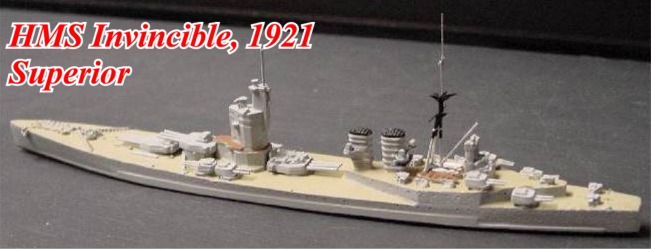 |
 |
| HMS
Invincible of 1921 by Superior by John Olsen |
|
Superior's "never built" battlecruiser HMS Invincible of 1921 is adapted from the Royal Navy's post WWI G3 battlecruiser design, one of a number of design studies undertaken by the DNC to provide Britain with a postwar battle fleet able to counter the massive building programs of the U.S. and Japan. Designs were designated by letter and number, with letter designations in reverse order starting from K reserved for battlecruisers, and in proper order from L for battleships. Numbers (2 and 3) referred to twin and triple turrets. After exploring several overlarge 18in gun designs (battlecruisers K2, K3, I3, H3 and battleships L2, L3, M2, M3) from October to December, 1920, the DNC accepted a reduction in main battery calibre to 16in and on 17 December, 1920, approved the G3 sketch for development into a final design for a class of 4 battlecruisers ordered the following October that most likely would have carried the names Invincible, Indomitable, Inflexible and Indefatigable, though the names St George, St Patrick, St Andrew and St Davis have also been speculated.
The G3 design embodied several features developed from the previous studies: concentration of the main battery forward (a Jackie Fisher notion that British ships never ran away, hence no need to fire astern), incorporation of the U.S. idea of "all or nothing" armor protection, and introduction of a tower bridge structure. The result would have been a ship 856 ft long with a displacement of 48,400 tons, armed with 9-16in/45 in 3 triple turrets on a long forecastle, 16-6in in 8 twin turrets and 6-4.7in AA, and geared steam turbines capable of 32k located aft of the main battery. Construction proved prohibitively expensive and was suspended on 18 November, 1921. All 4 ships were cancelled on 13 February, 1922, joining the other "cherry trees" in American and Japanese shipyards felled by the Washington Treaty. A similar battleship design (N3) with 9-18in eventually morphed into the, much reduced Nelson and Rodney.
Superior's model shows Invincible as she might have looked fully complete with flush deck, transom stern, and AA armament augmented to WWII level, probably the result of Superior's reusing turret and deck castings fron their Nelson model from which this was apparently developed. The awkward fantail tripod mast seen in some of the earlier sketches is eliminated, leaving a much more balanced profile. For some reason, the stacks have been given overly prominent horizontal ribbing, which suggests the access rings found on the funnels of Japanese ships, but which are absent on British funnels, where vertical staging lines were used for maintenance. Also present is the unfortunate solid tripod mainmast, which I replaced with plastic rod and brass wire. Otherwise the model is well done and comparable to Superior's recent efforts to upgrade the quality of its products. The casting seam is barely visible and flash is easily removed. I painted Invincible in a Mediterranean 507C gray mixed to match the S&S chip, with Pollyscale Old Concrete for the teak weather decks. Together with Superior's other Special Production Run models of Tosa, Amagi and South Dakota, Invincible is a must for any collector interested in this lost generation of capital ships. __________________________________________________________________________________________________________ |